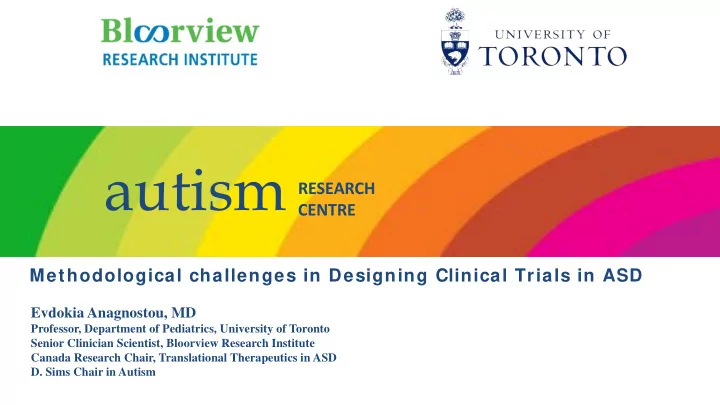

autism RESEARCH CENTRE Methodological challenges in Designing Clinical Trials in ASD Evdokia Anagnostou, MD Professor, Department of Pediatrics, University of Toronto Senior Clinician Scientist, Bloorview Research Institute Canada Research Chair, Translational Therapeutics in ASD D. Sims Chair in Autism
Disclosures • Consulting: Roche, Quadrant • Collaborations: SIEMENS • Funding: – Ontario Brain Institute, CIHR, NIH, DoD, HRSA, NCE-NeuroDevNet, Autism Speaks, Brain Canada, Azrieli Foundation – Pharma grant support: ROCHE – In kind support: AMO pharma. Simons foundation -CRA
Knowledg dge Biosta tatis istic tics Transla lation ion
Challenges in clinical trials in ASD • Construct confusion : – What to target (heterogeneity of phenotypes and biologies) – Phenotype – Construct confusion (e.g. actual diagnostic constructs: vague behavioral constructs: anxiety, social function vs withdrawal vs cognition, repetitive behaviors) – Biology: genomic heterogeneity, influence of common variants, gene X environment interactions – Biomarkers for: Diagnosis ? Early reads? Stratification? Pinto et al 2014
Challenges in clinical trials in ASD • Poor m easurem ent • Seaside Therapeutics trial of Arbaclofen – Construct confusion Unpublished data , Paul Wang – Poor Sensitivity to change – Developed for diagnosis; sample characteristics – High placebo response
Working group with academia, self advocacy organizations and industry Process and results presented to regulators Met monthly over 14 months, with 2 face to face meetings Systematic search of the literature covering publications to 2012 Measures evaluated for: Clinical domain coverage Psychometric properties (content and construct validity, internal consistency, inter-rater and test-retest reliability) Sensitivity to change Other considerations: Burden, availability in languages
Updates since 2015 publication: ABC-SW
Updates since 2015 publication: ABC-SW POND Network Riluzole vs placebo in ASD (co-Pis: Rob Nicolson, Terry Bennet) n=60 0 % Change ABC Social Wihdrawal Score -10 -20 POND Network -30 Tideglusib vs placebo in ASD (co-Pis: Rob Nicolson, Terry Bennet) -40 -50 p = 0.055 n=90 -60 Placebo AMO-02 Cohen’s D effect size = 0.44
Updates since 2015 publication: SRS
Updates since 2015 publication: Vineland POND Network Tideglusib vs placebo in ASD n=90 Placebo Arbaclofen N=58 (54 completers) N=57 (44 completers) Measure Baseline Week 12 Change Baseline Week 12 Change p-value Secondary Efficacy Measure Vineland-II 61.1 (12.9) 63.1 (13.4) 1.8 (7.5) 58.5 (12.1) 66.0 (18.5) 7.1 (10.7) 0.006 Socialization
Placebo response • High expectations – Patient factors: – Subjects / families – Severity: interaction with primary measure – Investigators – Age, sex, early in the • Non specific therapeutic course of disorder effects – Study factors: – Symptom variation – Informant • Biology – Measure – Imaging (reward system; – number of sites systems expected to respond to intervention) – length of trial – Genomics ( e.g. serotonin related – year of trial gene polymorphisms in anxiety, – # of visits Furmark etal 2008, monoaminergic tone in depression, Leuchter AF et al 2009)
Caveats • But – Vineland Social positive predictor of treatment vs placebo response – ??capacity
Intranasal oxytocin vs placebo in adolescents with ASD Oxytocin Holland Bloorview, U Toronto: Anagnostou Placebo University of Minesotta: Jacob 25 Week 12 Week 24 20 Change from baseline 15 10 5 0 -5 Emotional Social School Psychosocial Physical Total Functioning Functioning Functioning Health Health Score
Challenges in Clinical Trials in ASD • SAMPLE SIZES – Scarce phase 3 studies – Some studies have unacceptably low sample sizes even for phase 2 designs – Characteristics of populations – Standard of care in ASD
ARBA Study A Randomized Placebo-controlled Trial of ARBaclofen vs. Placebo in the Treatment of Children and Adolescents with ASD
Collaborations I m prove sam ple • AIMS-2 network sizes • Co-designed and harmonized protocols • Pooled secondary analysis • ~200 participants
Study Overview • Random ized, placebo-controlled, double-blind, parallel design • 1 6 w eeks of random ization • 1 6 w eeks open label Construct and outcom e m easure change e Hetereogeneity • Outcom e m easures: Primary: Vineland –Social; Secondary : ABC-SW • Biom arkers: Sensory processing, EEG, epigenetics • Lim it variability: verbal children
Exploratory Measures - aims • BOSCC – social abilities ; Autism Impact measure – AIM – core symptoms; PedsQL – quality of life New m easures • adaptive and global function (daily living skills and motor skills as measured by the Vineland- 3, and Clinical global Impression- Severity) • E lectrophysiology (EEG) and sensory discrimination Heterogeneity, early reads As this is also an embedded trial in a biomarker core [Province of Ontario Neurodevelopmental Disorders Network (POND)], we will explore whether cognitive/adaptive/global functioning, genomics and/or imaging characteristics are associated with treatment response or safety ( post hoc approach to stratification)
In s sum ummary • Challenges: construct confusion, heterogeneity of unclear structure, measurement issues, placebo response • We continue to learn lessons about placebo response and refine measurement • Despite construct confusion, biomarker and other marker discovery crucial to allow for both early reads and stratification • Successes will apply to multiple neurodevelopmental conditions, given overlapping biological constructs • Collaboration critical to adequate sample sizes
Recommend
More recommend